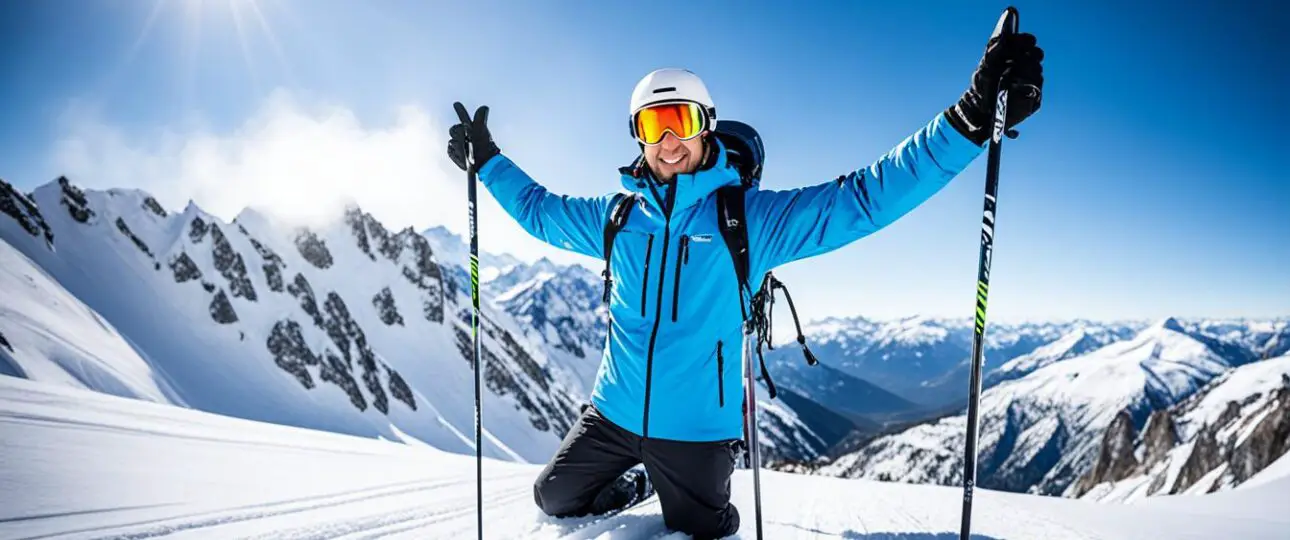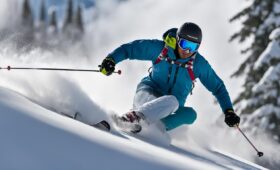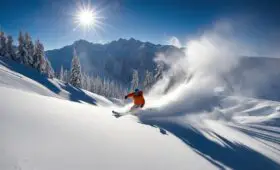When it comes to skiing, it’s not just your skis that matter. Ski poles play a crucial role in providing balance, stability, and propulsion. But finding the right ski pole length can be a challenge for many skiers.
That’s why we’ve created this comprehensive ski pole sizing guide to help you determine the correct length of ski poles for your unique needs. Whether you’re a beginner or an experienced skier, understanding how to size ski poles is essential for optimizing your skiing experience.
So, let’s dive in and explore the ins and outs of finding your perfect fit with our ski pole sizing guide and ski pole size chart.
Key Takeaways:
- Proper ski pole sizing: Choosing the correct ski pole length is crucial for comfort, balance, and performance on the slopes.
- Understanding the measurement: The general rule of thumb is to flip the ski pole upside-down and hold it right under the basket. Your elbow should comfortably sit by your hip, and your arms should be bent at approximately a 90-degree angle.
- Consider your skiing style: The purpose of your poles can influence their length. Park riders may prefer shorter poles for balance and tricks, while backcountry skiers may opt for adjustable poles for versatility.
- Factors to consider: Grips, straps, shaft materials, and basket types are all important factors to consider when choosing ski poles that suit your preferences and skiing style.
- Types of ski poles: Ski poles are available in various types designed for specific skiing styles, including racing, Nordic, powder, freestyle, and alpine poles.
How to Choose the Right Length Ski Poles
Picking out the right ski pole length is essential for optimal skiing performance. The general rule of thumb is to flip the ski pole upside-down and hold it right under the basket. Your elbow should comfortably sit by your hip, and your arms should be bent at approximately a 90-degree angle. You can also measure the distance between your hand and the ground with your elbow bent at a 90-degree angle and add about two inches to account for the portion of the pole that sticks into the snow.
Additionally, the purpose of your poles can influence their length. Park riders may prefer shorter poles for balance and tricks, while backcountry skiers may opt for adjustable poles for versatility. Utilize a ski pole size chart to help determine the right length for you.
When selecting your ski pole length, consider the following tips:
- Measure from under the basket: Hold the ski pole upside-down and place it right under the basket. Your elbow should rest comfortably by your hip, and your arms should form a 90-degree angle.
- Measure with an extended arm: With your elbow bent at a 90-degree angle, measure the distance from your hand to the ground and add two inches to account for the portion of the pole that penetrates the snow.
- Consider the purpose: Choose a pole length that suits your skiing style. Shorter poles are ideal for park riding, while backcountry skiers may benefit from adjustable poles for different conditions.
Choosing the Right Ski Pole Length Calculator:
Not sure what length ski pole to choose? Use our ski pole length calculator to help you find the perfect fit for your height, style, and skiing preference. Simply input your measurements, and our calculator will provide you with a recommended ski pole length.
Ski Pole Sizing Tips:
Here are some additional ski pole sizing tips to keep in mind:
- Height: As a general guide, short skiers may benefit from shorter poles, while taller skiers may require longer poles. However, personal preference and skiing style should also be considered.
- Skiing Style: Different skiing styles have varying pole length recommendations. Park riders may prefer shorter poles, while backcountry skiers may need longer or adjustable poles.
- Terrain: The type of terrain you primarily ski on can also influence your ski pole length choice. Steep slopes may require shorter poles for better balance, while deep powder conditions may call for longer poles for more leverage.
By following these sizing tips and utilizing a ski pole size chart or calculator, you can confidently choose the right length ski poles that suit your needs and enhance your skiing experience.
Adjustable Ski Poles
When it comes to ski poles, adjustable options provide a level of versatility that can greatly enhance your skiing experience. Adjustable ski poles allow you to easily change the length of the poles to suit different skiing conditions. These poles are particularly popular among backcountry skiers who need the flexibility to extend their poles for more pushing leverage while ascending and then shorten them for the descent.
Not only do adjustable ski poles offer practical benefits for backcountry skiing, but they also come with additional features that can further enhance your outdoor adventures. Some adjustable poles even come with removable ice picks, adding extra functionality and safety.
Furthermore, adjustable ski poles are an excellent choice for kids who are still growing. As children’s height can change rapidly, having adjustable poles ensures that they always have the correct length to support their skiing technique.
Consider adjustable ski poles if you value versatility, adaptability, and practicality. Whether you’re tackling backcountry terrain or skiing with kids, adjustable poles provide the flexibility you need for a more enjoyable and comfortable skiing experience.
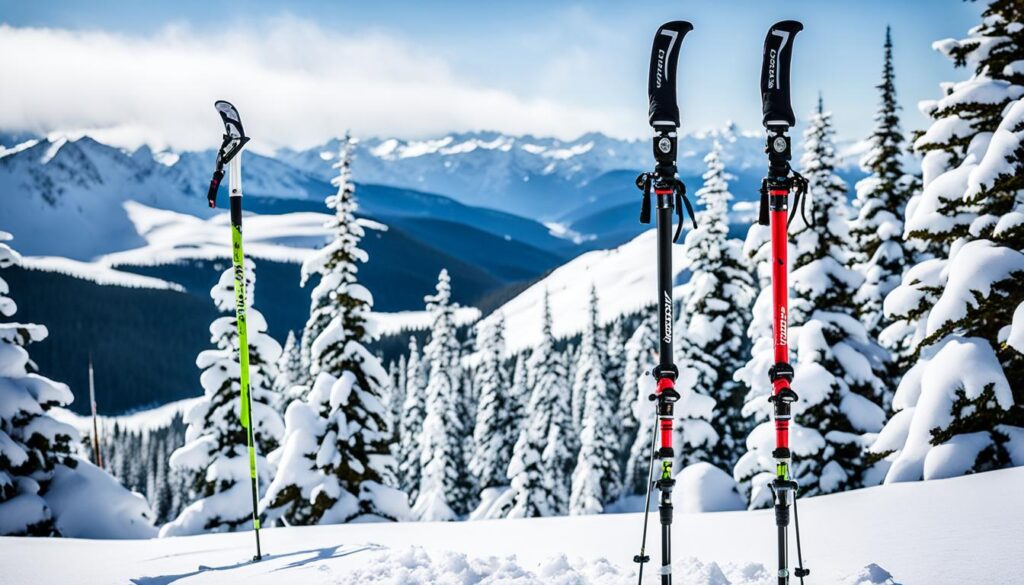
Factors to Consider – Grips, Straps, Shaft Materials, and Basket Types
When it comes to ski poles, it’s important to consider various factors that can greatly impact your skiing experience. From the grip you choose to the materials used in the shaft, each aspect plays a role in providing comfort, control, and performance on the slopes.
Grips: Comfort and Security
Choosing the right grip for your ski poles is essential for comfort and a secure hold. Grips come in various shapes, styles, and materials, so it’s important to find one that feels comfortable in your hand and provides the necessary grip. Many poles feature wider grips at the top and bottom, ensuring that your hand stays correctly positioned.
Straps: Safety and Convenience
Equally important are the straps on your ski poles, which serve both safety and convenience purposes. Straps keep the poles close by in case of falls and can be adjusted to your preferred size. Consider the length of the straps and whether you prefer to ski with or without them. Find the configuration that best suits your skiing style and provides the level of security and convenience you desire.
Shaft Materials: Durability and Performance
The material of the ski pole shaft greatly impacts its durability and performance. There are several options to choose from:
- Aluminum: Known for its durability and affordability, aluminum shafts are a popular choice for many skiers.
- Carbon Fiber: Offering lightweight strength, carbon fiber shafts provide excellent performance on the slopes.
- Composite Materials: These shafts provide flexibility and shock absorption, enhancing your overall skiing experience.
- Bamboo: For eco-conscious skiers, bamboo poles offer a sustainable alternative with their unique blend of durability and style.
Basket Types: Adaptability to Terrain
The basket at the bottom of the ski pole is designed to prevent the pole from sinking too far into the snow. Basket types vary, and choosing the right one depends on the terrain you’ll be skiing on:
- Larger Baskets: Ideal for deep powder conditions, larger baskets provide the surface area necessary to keep your poles on top of the snow.
- Standard Baskets: Suitable for most skiing scenarios, standard baskets strike a balance between functionality and versatility.
Consider the grip shape, strap configuration, shaft material, and basket type that best suit your preferences and skiing style. By selecting the right combination of these factors, you can enhance your performance, control, and overall enjoyment on the slopes.
The Different Types of Ski Poles – Racing, Nordic, Powder, Freestyle, and Alpine
Ski poles come in various types specifically designed for different skiing styles. Understanding the characteristics of each type can help you choose the perfect ski pole to enhance your performance on the slopes. Here are the different types of ski poles and their attributes:
Racing Ski Poles
Racing ski poles are lightweight and narrow, specially designed for speed and aggressive turns. These poles offer quick and precise movements, allowing racers to maintain control and maximize their performance in high-speed downhill races.
Nordic Ski Poles
Nordic ski poles are long, thin, and pointed, making them ideal for cross-country skiing on flatter terrains. They provide effective propulsion and help skiers maintain balance and rhythm while gliding through the snow.
Powder Ski Poles
Powder ski poles are equipped with wide baskets to prevent sinking in deep snow. They feature a thicker shaft with increased shock absorption properties, providing stability and support in challenging powder conditions.
Freestyle Ski Poles
Freestyle ski poles are shorter in length and have wider baskets, offering increased maneuverability and control in terrain parks. These poles enable freestyle skiers to execute tricks, jumps, and spins with ease.
Alpine Ski Poles
Alpine ski poles are versatile and suitable for various skiing styles. They typically have medium-sized baskets and straight shafts, providing all-around performance for different terrains and skiing techniques.
When selecting your ski poles, consider your skiing preferences and the type of skiing you enjoy the most. Understanding the characteristics and features of each ski pole type will help you make an informed decision that aligns with your specific needs.
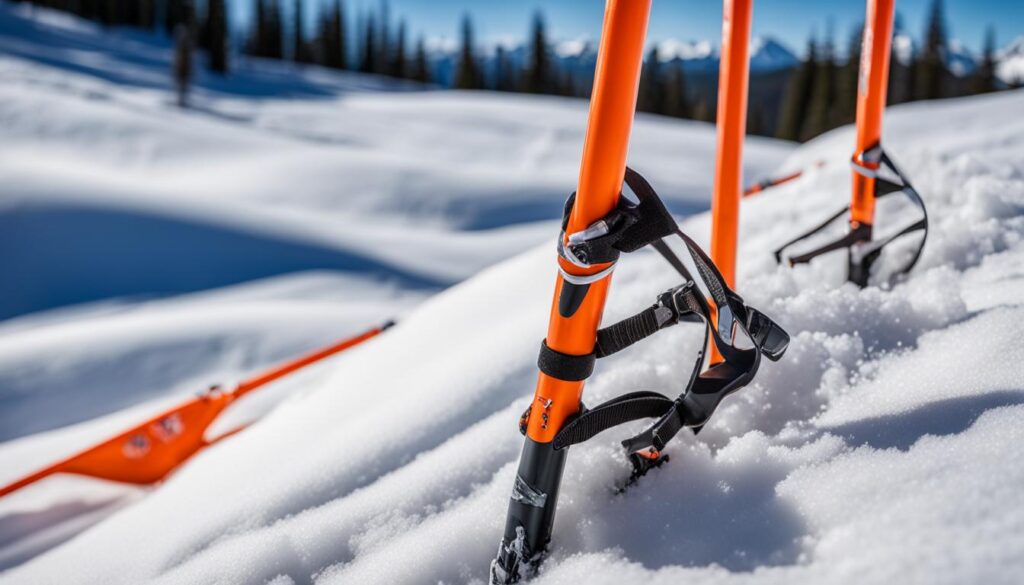
| Type | Description |
|---|---|
| Racing Ski Poles | Lightweight and narrow poles for speed and aggressive turns |
| Nordic Ski Poles | Long, thin, and pointed poles for cross-country skiing on flatter terrains |
| Powder Ski Poles | Poles with wide baskets and thicker shafts for deep snow and shock absorption |
| Freestyle Ski Poles | Shorter poles with wider baskets for maneuverability in terrain parks |
| Alpine Ski Poles | Versatile poles suitable for various skiing styles, with medium-sized baskets and straight shafts |
Conclusion
Finding the right ski pole length is essential for a comfortable and enjoyable skiing experience. By following this ski pole sizing guide and utilizing the ski pole size chart, you can determine the perfect fit for your skiing adventures. Take into consideration factors such as your height, skiing style, and terrain to select the ideal ski pole length.
Additionally, remember to consider your personal preferences for grip, straps, shaft materials, and basket types. These features can greatly impact your skiing performance and comfort on the slopes. Choose the ones that align with your preferences and enhance your overall skiing experience.
With the correct ski pole length and the right combination of features, you’ll have maximum control, stability, and balance on the slopes. So, whether you’re racing, cross-country skiing, or exploring powder-filled terrains, finding the perfect ski pole length is the key to unlocking your full skiing potential.
